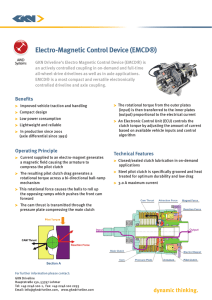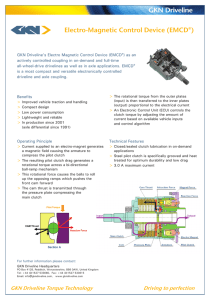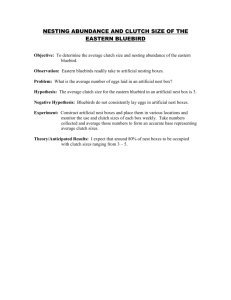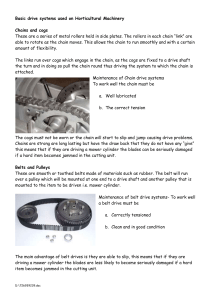Structure Analysis of Cast Iron for Dry Clutch of Amphibious Vehicle
advertisement
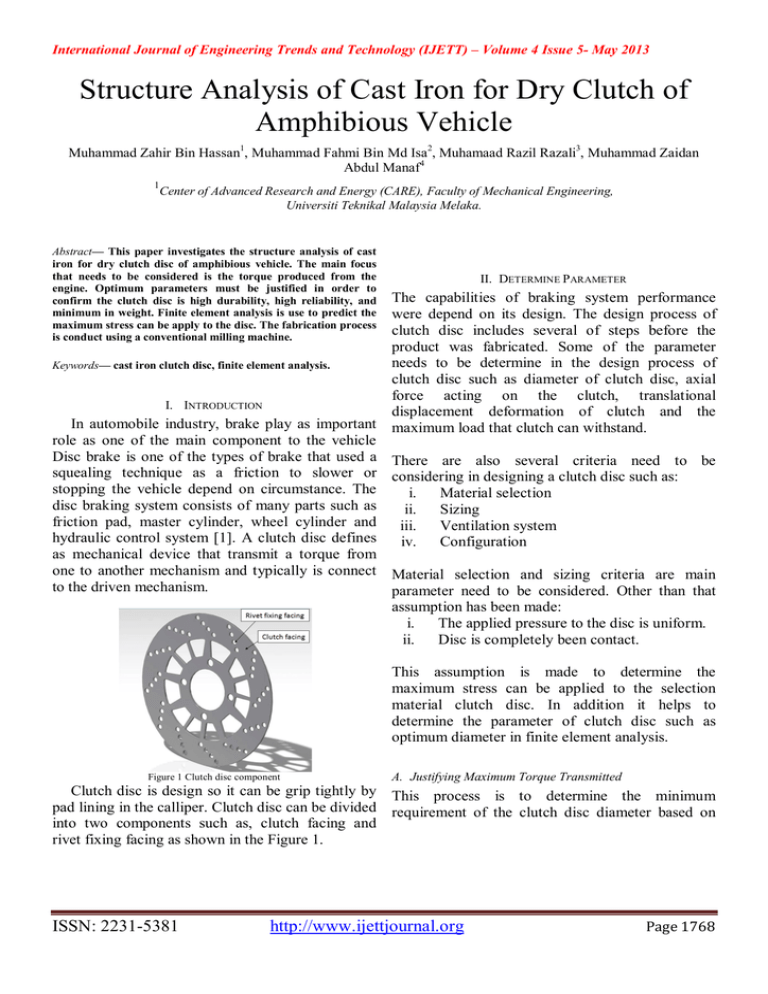
International Journal of Engineering Trends and Technology (IJETT) – Volume 4 Issue 5- May 2013 Structure Analysis of Cast Iron for Dry Clutch of Amphibious Vehicle Muhammad Zahir Bin Hassan1, Muhammad Fahmi Bin Md Isa2, Muhamaad Razil Razali3, Muhammad Zaidan Abdul Manaf4 1 Center of Advanced Research and Energy (CARE), Faculty of Mechanical Engineering, Universiti Teknikal Malaysia Melaka. Abstract— This paper investigates the structure analysis of cast iron for dry clutch disc of amphibious vehicle. The main focus that needs to be considered is the torque produced from the engine. Optimum parameters must be justified in order to confirm the clutch disc is high durability, high reliability, and minimum in weight. Finite element analysis is use to predict the maximum stress can be apply to the disc. The fabrication process is conduct using a conventional milling machine. II. DETERMINE PARAMETER The capabilities of braking system performance were depend on its design. The design process of clutch disc includes several of steps before the product was fabricated. Some of the parameter needs to be determine in the design process of Keywords— cast iron clutch disc, finite element analysis. clutch disc such as diameter of clutch disc, axial force acting on the clutch, translational I. INTRODUCTION displacement deformation of clutch and the In automobile industry, brake play as important maximum load that clutch can withstand. role as one of the main component to the vehicle Disc brake is one of the types of brake that used a There are also several criteria need to be squealing technique as a friction to slower or considering in designing a clutch disc such as: stopping the vehicle depend on circumstance. The i. Material selection disc braking system consists of many parts such as ii. Sizing friction pad, master cylinder, wheel cylinder and iii. Ventilation system hydraulic control system [1]. A clutch disc defines iv. Configuration as mechanical device that transmit a torque from one to another mechanism and typically is connect Material selection and sizing criteria are main to the driven mechanism. parameter need to be considered. Other than that assumption has been made: i. The applied pressure to the disc is uniform. ii. Disc is completely been contact. This assumption is made to determine the maximum stress can be applied to the selection material clutch disc. In addition it helps to determine the parameter of clutch disc such as optimum diameter in finite element analysis. Figure 1 Clutch disc component A. Justifying Maximum Torque Transmitted Clutch disc is design so it can be grip tightly by This process is to determine the minimum pad lining in the calliper. Clutch disc can be divided requirement of the clutch disc diameter based on into two components such as, clutch facing and rivet fixing facing as shown in the Figure 1. ISSN: 2231-5381 http://www.ijettjournal.org Page 1768 International Journal of Engineering Trends and Technology (IJETT) – Volume 4 Issue 5- May 2013 the automotive application. Clutch disc diameter is be justified by assume: i. Pressure applied are uniformly ii. Factor of safety (FOS) is 1.5 iii. Lining pad material is woven asbestos. iv. Coefficient of friction is set to f = 0.15 v. Maximum pressure applied onto clutch, Pmax= 682kPa Once model will be created using CAD software, the final diameter of the clutch disc is decided as described in Table I. Hence, the result for maximum allowable torque and axial force is show in Table II. TABLE I Clutch disc geometrical properties Properties Inner radius clutch disc ri Outer radius clutch disc ro Figure 2 Direction of Axial force of clutch facing. Value 58 mm 220mm TABLE II Clutch disc geometrical properties Using T = πPmax ri f (ri2-ro2)N (1) Properties Maximum value of torque T Axial Force Fa Value 59.43 Nm 10067.0811 N where: T Pmax f ri ro N = Torque transmit, Nm = maximum pressure applied onto clutch, Pa = coefficient of friction = radius inner = radius outer = number of friction surface C. Finite Element Analysis For a rotational motion, structure analysis is conducted in static case by using computer aided design (CAD) software ANSYS version 14.0. The properties of cast iron clutch disc used for the present analysis are shown in the Table III. TABLE III Properties of cast iron clutch disc. B. Justifying Axial Force Axial force is force that exert on perpendicular to the surface as shown in Figure 2. For this design, the axial force was representing as calliper that exert on the surface of the clutch. Therefore calculation must be made to be used in finite element analysis. To calculate the axial force, equation (2) is used Fa = πPmax Di (Do-Di) (2) Properties Young modulus Poisson ratio Density Thermal expansion Tensile ultimate Strength Compressive ultimate strength Value 1.1x1011 Nm-2 0.28 7200 kgm-3 1.1x10-5 K.deg 2.4x108 Nm-2 8.24x108 Nm-2 The cast iron material was applied to the model followed by meshing the model as shown in Figure 3. Boundary condition was set by clamping at the static region. The applied moment was set in axial direction with magnitude 59.43 Nm. where: D0 = Outer Diameter Di = Inner Diameter ISSN: 2231-5381 http://www.ijettjournal.org Page 1769 International Journal of Engineering Trends and Technology (IJETT) – Volume 4 Issue 5- May 2013 the cast iron, there will be a wear and tear in long period. Fig. 3 Meshing model. The result in finite element analysis was determined Fig. 5 Von-mises stress of clutch facing. and the total deformation is shown in Figure 4. The maximum total deformation is 1.0377x10-5 mm. Since the gap between clutch disc and pad lining is III. FABRICATION PROCESS greater than maximum total deformation. Thus, it is Fabrication process was conducted after the finite acceptable. element analysis using conventional milling machine as shown in Figure 6. The subject was clamp tightly so there is no slipping during drilling process. In these process four holes was drilled on the clutch disc carefully with tolerance ±0.001mm. These four holes will be used as mounted for clutch disc to the wheel hub in the experimental analysis. Fig. 4 Total deformation of clutch facing. The maximum von misses stress is 0.034286 MPa and the minimum von misses stress is 5.24x10-6 MPa. Both of these results were shown in Figure 5. It shows that the maximum stress will be exert on the four hole that mounted to the wheel hub. Since the result maximum Von-mises stress from finite element analysis is greater than the yield strength of ISSN: 2231-5381 http://www.ijettjournal.org Fig. 6 Conventional milling machine. Page 1770 International Journal of Engineering Trends and Technology (IJETT) – Volume 4 Issue 5- May 2013 IV. CONCLUSIONS This paper explains about the structure analysis of cast iron clutch disc. The clutch disc will be test in amphibious vehicle for experimental analysis to determine its durability. The result of this paper will be used for the future study in automotive application. REFERENCES [1] Sivarao, M. Amarnath, M.S.Rizal, A.Kamely (1990), An Investigation Toward Economical Brake Lining Wear Alert System, International Journal of Engineering & Technology IJET Vol.9 No9. [2] Jin-Le Zhang, Biao Ma, Ying –Feng Zhang and He Yan Li (2009): Simulation and Experimental Studies on the Temperature Field of a Wet Shift Clutch during one Engagement, in: International Conference of Computational Intelligence and Software Eng, (CiSE) 2009 IEEE, 1113.12.2009, pp.1-5. [3] S. Sfarni, E. Bellenger, J. Fortin, and M. Malley, (2009) Finite element analysis of automotive cushion discs, Thin Walled Structures, vol.47, pp. 474-483, 2009. ISSN: 2231-5381 http://www.ijettjournal.org Page 1771
